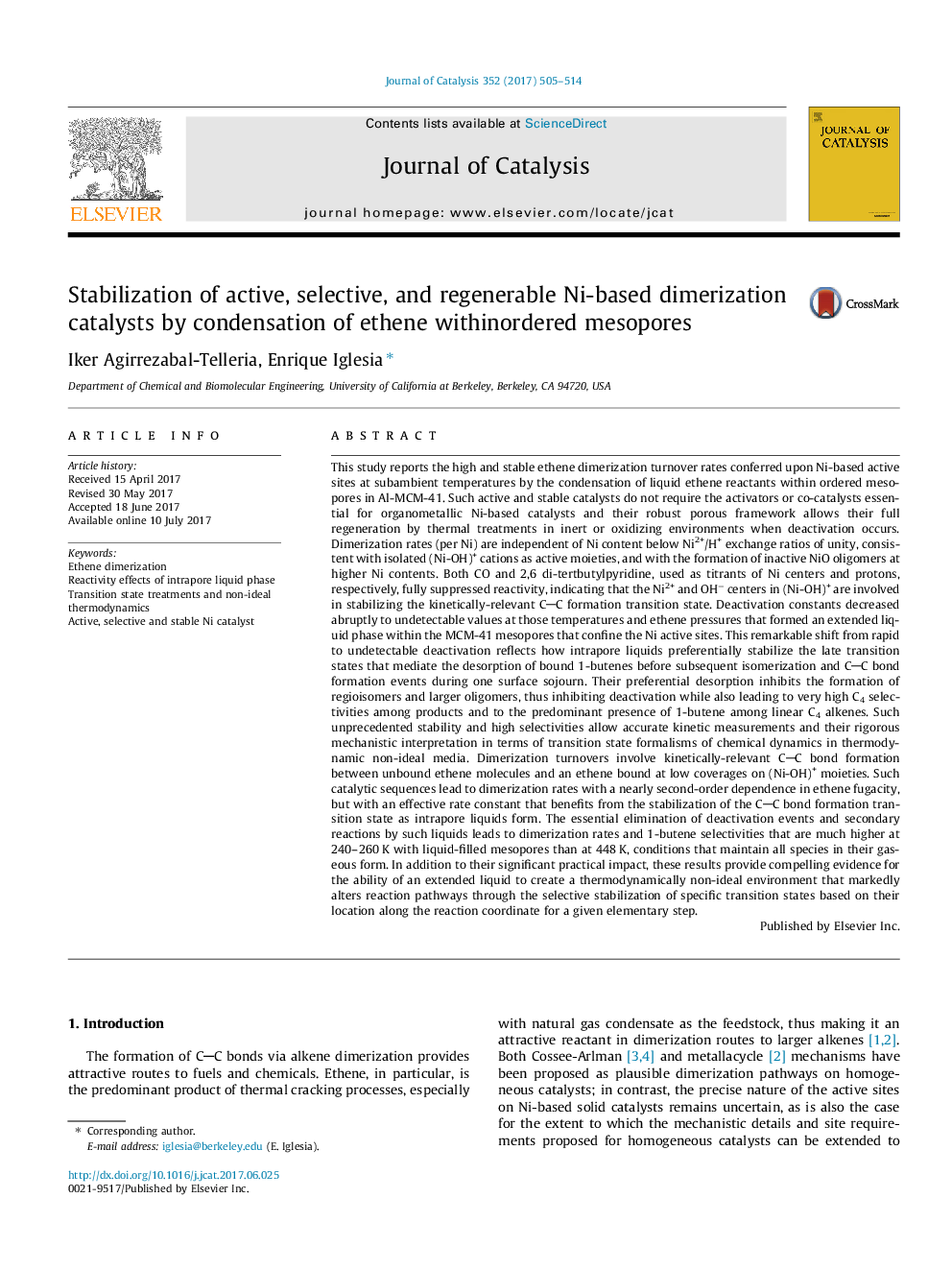| کد مقاله | کد نشریه | سال انتشار | مقاله انگلیسی | نسخه تمام متن |
|---|---|---|---|---|
| 6455444 | 1419757 | 2017 | 10 صفحه PDF | دانلود رایگان |
- Intrapore liquid ethene leads to unprecedented Ni site stability and reactivity at sub-ambient temperatures.
- Stability reflects solvation of late desorption transition states that prevent secondary growth and isomerization.
- Stability allows elucidation of mechanism and of involvement of isolated grafted {Ni-OH}+ species as active sites.
- Titrations during reaction demonstrate concerted involvement of protons and Ni centers in ethene dimerization events.
- Transition state treatments of thermodynamic non-idealities account for reactivity enhancements by intrapore liquids.
This study reports the high and stable ethene dimerization turnover rates conferred upon Ni-based active sites at subambient temperatures by the condensation of liquid ethene reactants within ordered mesopores in Al-MCM-41. Such active and stable catalysts do not require the activators or co-catalysts essential for organometallic Ni-based catalysts and their robust porous framework allows their full regeneration by thermal treatments in inert or oxidizing environments when deactivation occurs. Dimerization rates (per Ni) are independent of Ni content below Ni2+/H+ exchange ratios of unity, consistent with isolated (Ni-OH)+ cations as active moieties, and with the formation of inactive NiO oligomers at higher Ni contents. Both CO and 2,6 di-tertbutylpyridine, used as titrants of Ni centers and protons, respectively, fully suppressed reactivity, indicating that the Ni2+ and OHâ centers in (Ni-OH)+ are involved in stabilizing the kinetically-relevant CC formation transition state. Deactivation constants decreased abruptly to undetectable values at those temperatures and ethene pressures that formed an extended liquid phase within the MCM-41 mesopores that confine the Ni active sites. This remarkable shift from rapid to undetectable deactivation reflects how intrapore liquids preferentially stabilize the late transition states that mediate the desorption of bound 1-butenes before subsequent isomerization and CC bond formation events during one surface sojourn. Their preferential desorption inhibits the formation of regioisomers and larger oligomers, thus inhibiting deactivation while also leading to very high C4 selectivities among products and to the predominant presence of 1-butene among linear C4 alkenes. Such unprecedented stability and high selectivities allow accurate kinetic measurements and their rigorous mechanistic interpretation in terms of transition state formalisms of chemical dynamics in thermodynamic non-ideal media. Dimerization turnovers involve kinetically-relevant CC bond formation between unbound ethene molecules and an ethene bound at low coverages on (Ni-OH)+ moieties. Such catalytic sequences lead to dimerization rates with a nearly second-order dependence in ethene fugacity, but with an effective rate constant that benefits from the stabilization of the CC bond formation transition state as intrapore liquids form. The essential elimination of deactivation events and secondary reactions by such liquids leads to dimerization rates and 1-butene selectivities that are much higher at 240-260Â K with liquid-filled mesopores than at 448Â K, conditions that maintain all species in their gaseous form. In addition to their significant practical impact, these results provide compelling evidence for the ability of an extended liquid to create a thermodynamically non-ideal environment that markedly alters reaction pathways through the selective stabilization of specific transition states based on their location along the reaction coordinate for a given elementary step.
73
Journal: Journal of Catalysis - Volume 352, August 2017, Pages 505-514
